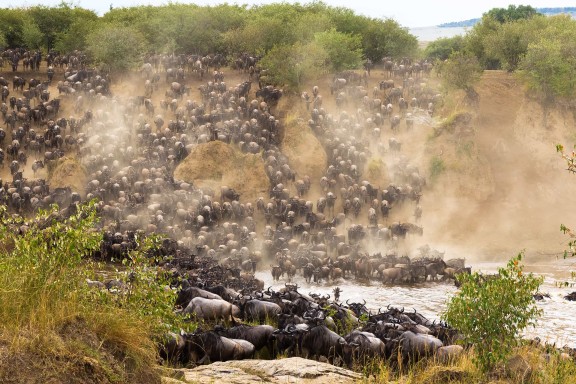Imagine a moving mirage of an estimated 1.5 million wildebeest, 200,000 zebra and 500,000 Thompson’s gazelle that move en masse across the magnificent plains of East Africa. This is the profound, spectacular and ancient phenomenon known as the great migration or the ‘greatest wildlife show on earth.’

‘No matter how much you anticipate the migration, when it starts – and in my experience, it usually starts early in the morning – the feeling is a palpable and visceral sense of unease,’ says Deborah Calmeyer, CEO, and founder of ROAR AFRICA. ‘To be woken at 3 am with the ground literally thundering beneath you is an exhilarating reminder of our deepest and most ancient stirrings.’ It’s also a journey fraught with danger as the massive herds of wildebeest, zebra and gazelle are tracked relentlessly by some of Africa’s great predators including lion, leopard, cheetah, and hyena.
As such it’s a once-in-a-lifetime experience that never fails to top the list of the most ardent safari goers and conservationists. However, the timing and route of the migration can change from year to year, and this makes planning a trip problematic. ‘We make use of on-the-ground intelligence to monitor the situation closely thereby pin pointing with accuracy when and where to view it,’ says Deborah. ‘We also make use of both fixed and mobile camps, so that our guests literally have ringside seats at the stages they’re most wanting to experience.’
But what is the great migration? And why does it happen? Essentially it is the mass movement of large herds of wildebeest, eland, zebra and Thompson’s gazelle, whose migration north is triggered in January or February by the start of the annual rains on the Serengeti Plains. This prompts the female population to give birth to an estimated 500 000 young wildebeest that by the end of April or May are mobile enough to move. It is then, when the last of the rains have fallen, and the area is too dry to sustain their massive numbers, that the herd moves further northwards towards the plains of the Masai Mara for mating season.
In June or July, they move across the plains of the Maasai Mara crossing the notoriously, crocodile-infested Mara River spurred on by a herd instinct that has them crashing down the banks of the river and braving the crocodiles that lie in wait. It’s heartbreaking to witness, especially when you learn that an estimated 250 000 wildebeest die every year from drowning or breaking their legs in river crossings, not to mention the plethora of predators that lie in wait. But it’s what makes the migration the spectacle it is. And for those that make it, they cross back into the Serengeti again and head down towards their calving grounds in the south of the park, to begin the cycle all over again.
For more information on the Great Migration or if you would like us to put together a migration itinerary, email us at welcome@roarafrica.com



